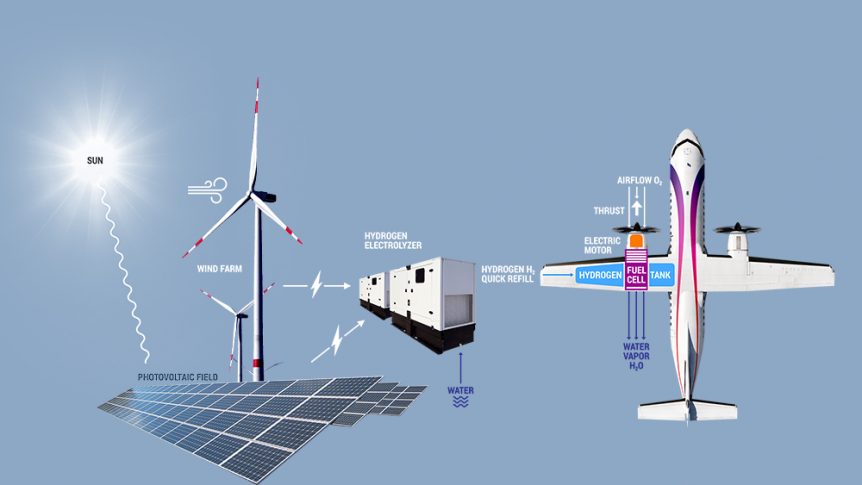Tuesday, June 23, ZeroAvia flew a hydrogen-powered Piper Malibu from Cranfield Airport in England., eight time zones from ZeroAvia’s home base in Hollister, California. Flown by Andrew Dixon, that and a subsequent flight gained extra publicity for “a James Bond stunt pilot*” helming the first electric aircraft capable of carrying passengers from a United Kingdom airport. Dixon reported that the battery-powered Piper Malibu needed 10 per cent less distance for take-off and climbed faster than normal. The Airplane Was the Real Star Reflecting the high-flying status of the test pilot, the airplane, part of a government-funded “HyFlyer” project, flew two missions on two days of 15 and 25 minutes each. Its two automotive-based batteries easily carried the six-passenger aircraft on its tours of the Bedfordshire countryside. The second of two Piper Malibus to be converted by ZeroAvia, the craft will be converted to hydrogen power before an October or November “300-mile flight from Orkney to an airport on the Scottish …
Little Green Beads to Power Your UAV or Ultralight
January 19 marked the first flight by a Raptor UAS drone using pelletized hydrogen to power a fuel cell that generates electricity and makes the propeller turn. Energy Pellets Cella Energy, a Scottish-based enterprise, is now producing small quantities of their little green beads (just in time for Mardi Gras), filled with solid-state hydrogen. Claimed to have “two or three times” the energy per weight of the best of lithium-ion batteries, Cella’s pellets are designed to enable low-pressure transportation of hydrogen in a form that allows fueling to take place with a bit of magic sleight of hand. Looking like miniature green dumplings, Cella’s mix of plastic and encapsulated hydrogen has the advantage of using existing infrastructure, “with minimal alterations.” Think of the pellets as a dumpling with a hydrogen filling which can be repeatedly extracted and refilled. How many refillings is not stated at this time. Recycled Energy The pellets release their hydrogen into a fuel cell when they are …
Turbocharged Fuel Cells
The Engineer, a British publication, reports on a turbocharger for fuel cells. Because a fuel cell is a cross between a combustion engine and an electric motor, the concept of pushing extra air through the fuel cell to increase power is similar to that of turbocharging a regular two- or four-stroke engine. The publication says this could double the output of a hydrogen fuel cell. Like other combustion engines, a fuel cell can be limited by the airflow entering, that supply limiting their ability to release positively-charged hydrogen ions. Bryn Richards, CEO of Aeristech, explains, “Our proprietary high speed motor and control technology allows us to deliver air at a much higher pressure [than existing systems]. No other motor control arrangement is able to deliver at this pressure with such a high efficiency.” Without a lot of detailed information from Aeristech, The Engineer suggests the system uses a “sophisticated control system capable of maintaining a very consisten torque output. This …
More Power without Rare Earth Minerals
Ricardo, a long-time developer of internal combustion engines, has become a major force in the electric motor field, too. Its latest offering is an 85 kilowatt synchronous reluctance drive designed primarily for electric vehicle traction applications, made with advanced manufacturing techniques and no rare earth minerals. Without spilling any number beans other that the expected power output, Ricardo says that, “Using a conventional distributed stator winding, the Ricardo synchronous reluctance electric machine is a highly innovative design that makes use of low-cost materials, simple manufacturing processes and uncomplicated construction. It has a rotor made from cut steel laminations, which are used to direct and focus the flux across the air gap. By maximizing this flux linkage between the stator and rotor, performance can be optimized within a tightly packaged, low weight and rare earth element free design. Paul Rivera, Managing Director of the Ricardo hybrid and electric vehicle systems business, explains the impetus to develop such motors. “As the market …


